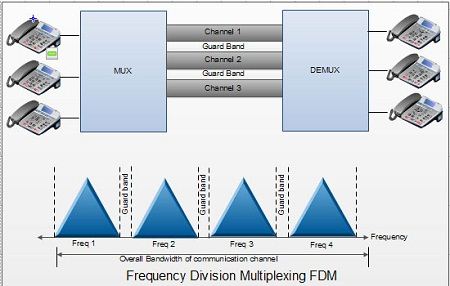In Frequency Division Multiplexing (FDM), multiple channels are combined onto a single aggregate signal for transmission. The channels are separated in the aggregate by their frequency. It is explained in the Figure where a frequency dimension is subdivided into several non-overlapping frequency bands. Each channel ci is allotted its own frequency band as depicted in Figure.
 There are always some unused frequency spaces between channels, known as guard bands. These guard bands reduce the effects of overlapping between adjacent channels and therefore, reduces a condition more commonly referred to as crosstalk.
There are always some unused frequency spaces between channels, known as guard bands. These guard bands reduce the effects of overlapping between adjacent channels and therefore, reduces a condition more commonly referred to as crosstalk.
FDM was the first multiplexing scheme to enjoy wide scale network deployment, and such systems are still in use today and are used with analog transmission. However, Time Division Multiplexing is the preferred approach today. The main disadvantage of FOM is the tremendous wastage of frequency resources for all time. Because of this reason, the number of channels is also restricted In FDM scheme.
 Dinesh Thakur holds an B.C.A, MCDBA, MCSD certifications. Dinesh authors the hugely popular
Dinesh Thakur holds an B.C.A, MCDBA, MCSD certifications. Dinesh authors the hugely popular